Trilliant Networks SC4121 802.11 BASED, SINGLE BAND FIXED WIRELESS NODE User Manual SkyConnector Install
Trilliant Networks, Inc. 802.11 BASED, SINGLE BAND FIXED WIRELESS NODE SkyConnector Install
Contents
- 1. Users Manual 1
- 2. Users Manual 2
Users Manual 1

SkyPilot
SkyConnector Outdoor
Installation
Contents
About This Guide 5
Audience and Purpose 6
How This Guide Is Organized 6
Conventions Used in This Guide 7
Chapter 1 Introduction 9
Solution Overview 10
Mesh Network 10
SkyGateway 12
SkyExtender Devices 12
SkyConnector and SkyAccess DualBand 13
Chapter 2 The SkyConnector Outdoor Installation Kit 15
Kit Contents 16
What Else You Need 16
Chapter 3 Installing a SkyConnector 19
Planning your Installation 20
Cabling the SkyConnector 21
Powering on the SkyConnector 23
Optimizing Location 26
Monitoring SkyConnector Status 28
Mounting the SkyConnector 29
Configuring the SkyConnector 31
Accessing the Command-Line Interface 32
Troubleshooting 33
Appendix A Grounding Guidelines 35
General Grounding Strategy 35
Making Connections “Gas-Tight” 36
Checking Cold-Water Pipe Integrity 37
Measuring Resistance 37
Adding Surge Protection 37
Grounding Checklist 38
Appendix B FCC Statements 39

About This Guide
This guide explains how to install and set up a SkyPilot™ SkyConnector™
Outdoor to provide wireless network access to users of a SkyPilot wireless mesh
network. It assumes administrator-level knowledge of IP networks and a
familiarity with configuring wireless devices.
Chapter Highlights
• Audience and purpose
• How this guide is organized
• Conventions used in this guide
SkyPilot SkyAccess DualBand Installation 6
Audience and Purpose
This guide provides directions for installing and setting up a SkyPilot
SkyConnector Outdoor device that can provide access to users of a SkyPilot
wireless mesh network.
This guide assumes administrator-level knowledge of IP networks and a
familiarity with configuring wireless devices.
How This Guide Is Organized
This guide is organized as follows:
• Chapter , “ 1,” provides an overview of the SkyPilot Networks solution,
describes the SkyPilot devices, and then illustrates how they combine to form
a mesh network.
• Chapter , “2,” provides the information you need before you begin your
installation.
• Chapter , “ 3,” provides instructions for the physical installation of the
SkyConnector Outdoor as well as background information about configuration
and references to associated procedures.
• Appendix , “ A,” provides direction on protecting your SkyPilot device with
proper grounding and surge protection.
• Appendix , “ Error! Reference source not found.,” provides the FCC radio
frequency interference statements for the SkyConnector Outdoor.
• Appendix , “ C” provides technical specifications for the SkyConnector
Outdoor.
SkyPilot SkyAccess DualBand Installation 7
Conventions Used in This Guide
This section describes the text and syntax conventions used throughout this
guide.
Text Conventions
This guide uses the following text conventions:
• Italic is used to introduce new terms.
• Bold is used to indicate what you click or type in a graphical user interface
(for example, commands names or text being entered). In examples showing
user interaction with the command-line interface, bold is used to indicate user
input as opposed to command output.
• A monospace font is used for code elements (variable names, data values,
function names, and so forth), command lines, scripts, and source code
listings.
• Italic-monospace is used for replaceable elements and placeholders within
code listings.
Syntax Conventions
This guide uses the following conventions when showing syntax:
• Angle brackets, “<“ and “>”, enclose mandatory elements. You must enter
these elements. For example:
ping <IP-address>
• Square brackets, “[“ and “]”, enclose optional elements. You can omit these
elements. For example:
show filter [filter-table-number]
Square brackets are also used to show the current value of parameters in
the output of some commands.
• A vertical bar, “|”, separates choices. For example:
show bridge [cache | port]

SkyPilot SkyAccess DualBand Installation 9
Introduction
This chapter provides an overview of the SkyPilot Networks solution,
describes the SkyPilot devices, and then illustrates how they combine to
form a mesh network.
Chapter Highlights
• Solution overview
• Mesh network
• SkyGateway
• SkyExtender devices
• SkyConnector
1
SkyPilot SkyAccess DualBand Installation 10
Solution Overview
SkyPilot Networks delivers a wireless, end-to-end broadband solution
that seamlessly supports high-capacity, high-coverage mesh networks.
Designed for managed-access networks and service providers, the
SkyPilot network takes broadband wireless the “last mile” with a cost-
effective, robust infrastructure solution.
Based on a high-performance architecture that deploys intelligent
antenna arrays, the SkyPilot network delivers a dynamic broadband
solution with significant advantages for business and home users.
SkyPilot wireless devices are simple to install and easily fit into any type
of wireless environment—metropolitan, business, or home.
The auto-discovery and rapid provisioning features of a SkyPilot wireless
mesh network can greatly reduce deployment and maintenance costs.
Multiple topology options and network scalability create intriguing options
for rapidly expanding a metro Wi-Fi customer base.
SkyPilot devices’ multiple antenna configurations work within mixed-use
environments of municipal applications and broadband Internet access,
supporting public-private partnerships such as public safety services.
Mesh Network
The typical configuration for a SkyPilot network is a mesh topology, which
uses SkyExtenders to extend range and add network flexibility. In a mesh
configuration, subscribers can either connect directly to the SkyGateway
or connect indirectly via SkyExtenders (see Figure ). In addition to
adding range, a mesh network allows connections from locations where
obstructions prevent line-of-sight access to a SkyGateway hub.
Mesh networks are ideal for dense subscriber environments, for filling in
coverage “holes,” and for reaching subscribers in areas where RF
communication is obstructed by hills, trees, buildings, or other obstacles.
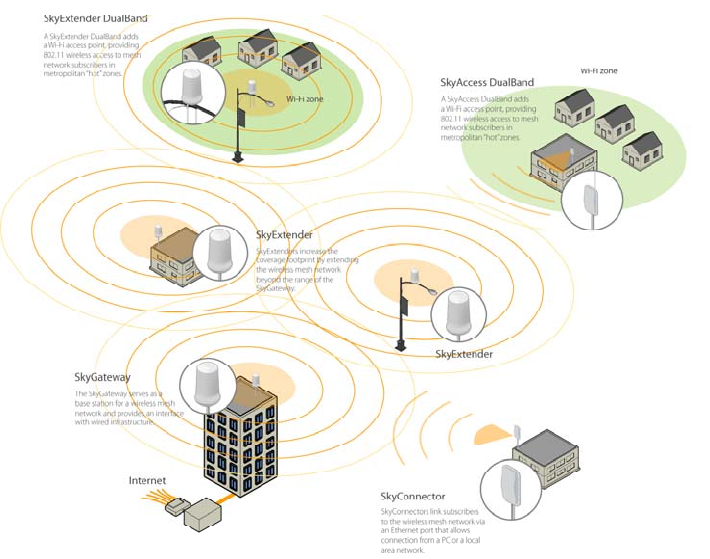
SkyPilot SkyAccess DualBand Installation 11
Figure 1. SkyPilot wireless mesh network
SkyPilot SkyAccess DualBand Installation 12
SkyGateway
The SkyGateway operates as a base station for a wireless mesh
network. It provides an interface between wired infrastructure and a
wireless network of subscribers who enjoy secure, high-speed access to
the Internet or to wide area networks.
A SkyPilot wireless network requires at least one SkyGateway for
operation. If necessary, you can add additional SkyGateways to increase
network capacity or provide redundancy.
The SkyGateway typically resides at a location with easy access to wired
infrastructure—usually a POP (point of presence) or data center.
For optimal performance, install the SkyGateway on an elevated site
such as a cell tower or the top of a tall building.
SkyExtender Devices
SkyExtenders, SkyExtender DualBands, and SkyExtender TriBands
provide a cost-effective way to add capacity and balance network loads
by operating as “repeaters” to extend the wireless range of a
SkyGateway (see Figure ). You can add any SkyExtender device to
your network to expand your coverage footprint and provide redundancy
through SkyPilot’s mesh networking features. SkyExtender devices
(except DualBands) can provide subscribers with a direct connection to
the wireless network via the device’s Ethernet port.
SkyExtender DualBand is a dual-radio solution that combines SkyPilot’s
long-range, high-capacity 5 GHz mesh backhaul with a high-powered 2.4
GHz 802.11b/g access point that allows service providers and
municipalities to offer standard Wi-Fi services over great distances—for
targeted hot zones or dense, ubiquitous coverage patterns.
SkyExtender TriBand integrates a 5.8 GHz mesh backhaul with the
DualBand’s access point and adds a third radio accessible through a
second access point. The second access point leverages the 4.9 GHz
Public Safety band, using 802.11a communication protocol. Each access
point uses a single antenna, and these
SkyPilot SkyAccess DualBand Installation 13
antennas have similar coverage patterns, providing a cost-effective
solution for municipal networks.
For optimal performance, install the SkyExtender in an elevated location
such as a roof, tower, or utility pole.
SkyConnector and SkyAccess DualBand
SkyConnectors link your subscribers to the SkyPilot wireless network. An
Ethernet port on the device allows a connection to a subscriber’s
computer, or to a local area network (LAN) via a data switch or router.
Designed for installation by the service provider, the SkyConnector
attaches to an external structure such as an eave, roof, or pole.
The SkyAccess DualBand offers the same features as a SkyConnector,
plus a Wi-Fi access point that enables service providers and
municipalities to provide standard 802.11 wireless access over great
distances, for targeted hot zones, or for dense coverage patterns.

SkyPilot SkyAccess DualBand Installation 15
The SkyConnector Outdoor
Installation Kit
Your SkyPilot SkyConnector Outdoor installation kit provides the basic
equipment you need to install the device and configure it for operation on
a SkyPilot wireless mesh network. This chapter describes that equipment
and lists additional items you should have on hand before starting
installation.
Chapter Highlights
• Kit contents
• What else you need
2
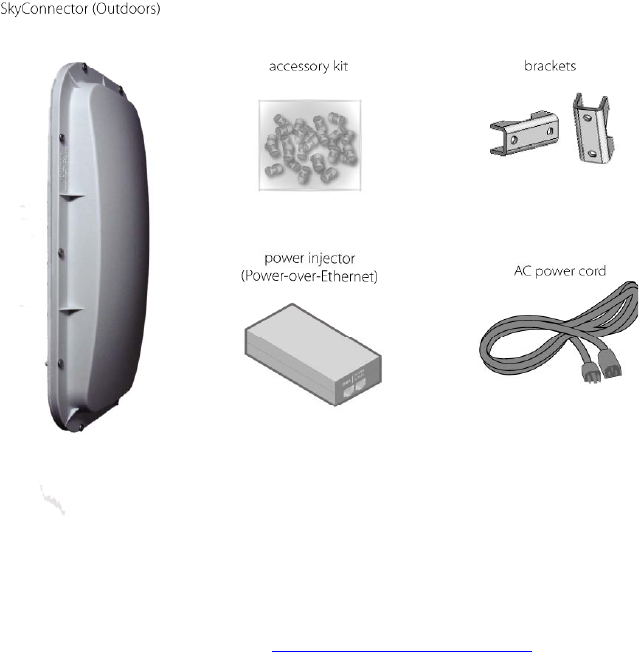
SkyPilot SkyAccess DualBand Installation 16
Kit Contents
Figure 2-1 shows the contents of the SkyConnector Outdoor installation
kit.
Figure 2-1. SkyPilot Outdoor installation kit
SkyPilot separately offers accessories for different types of installation,
including a surge suppressor and a tilt mount kit. For more information,
visit the SkyPilot website at www.skypilot.com/support/.
What Else You Need
Before starting installation, you also need the following:
• For basic mounting:
o Phillips screwdriver
• For pole mounting:
SkyPilot SkyAccess DualBand Installation 17
o Magnetic level
o Steel pole between 1 1/8" (2.87 cm) and 1 3/8" (3.48 cm) in
diameter
• For network cabling:
o A spool of CAT5 network cable (shielded cable is
recommended)
NOTE Ethernet cabling must comply with NEC/CEC
requirements for outdoor CAT-5 cables. The cabling’s
outer jacket must be clearly marked as CAT-5e per
ANSI/TIA/EIA-568-B.2.
o Crossover cable (for connecting to a an access point, switch,
or router)
o RJ-45 connectors (connectors without a protective “boot” are
recommended)
o RJ-45 crimping tool
• For configuration:
o Computer with a serial port, a terminal emulation program, a
network interface card, and a Web browser (laptop
recommended for convenience)

SkyPilot SkyAccess DualBand Installation 19
Installing a SkyConnector
This chapter provides instructions for planning and performing the
physical installation of a SkyConnector Outdoor.
Chapter Highlights
• Planning your installation
• Cabling
• Powering up the SkyConnector
• Optimizing location
• Monitoring SkyConnector status
• Mounting
• Configuring the SkyConnector
• Accessing the command-line interface
• Troubleshooting
3
SkyPilot SkyAccess DualBand Installation 20
Planning your Installation
In a typical wide area wireless mesh network, you’ll install a
SkyConnector on a utility pole or the roof of a building. The effective
range of a SkyConnector is usually proportional to the height of the
installation.
When choosing a site for a SkyConnector Outdoor, consider the radio
frequency (RF) environment and the physical layout of the area.
Trees, buildings, and hills can attenuate or block a wireless signal. When
assessing a site, examine the overall topology of the wireless path for
possible obstructions—both existing and planned—as well as seasonal
changes of foliage and tree growth. The RF environment is dynamic, and
can deteriorate over time as structures appear or are relocated.
Plan to use test signals to determine the suitability of the link topology for
target applications. Interference on your desired frequency results in
overlapping signals, causing outages or intermittent drops in throughput.
Once you’ve identified a potential site, use a topographic map or path
profile software to ensure that terrain or obstacles will not interfere with
the links.
Your site survey should include an RF scan to identify available
frequencies. You should also check your preferred frequency at all
locations. A frequency that’s clear at one location may be crowded at
another. Frequency planning is a critical factor in planning and
implementing a wireless network. (For device operating frequencies, see
Appendix , “ C.” )
The site survey process should be ongoing. To verify that a site is
relatively free of interference, make site audits every six to twelve
months, scheduling regular maintenance visits to coincide with the site
audits.
NOTE Plan to configure the SkyConnector Outdoor before mounting it.
Some steps, such as those requiring serial console access, are
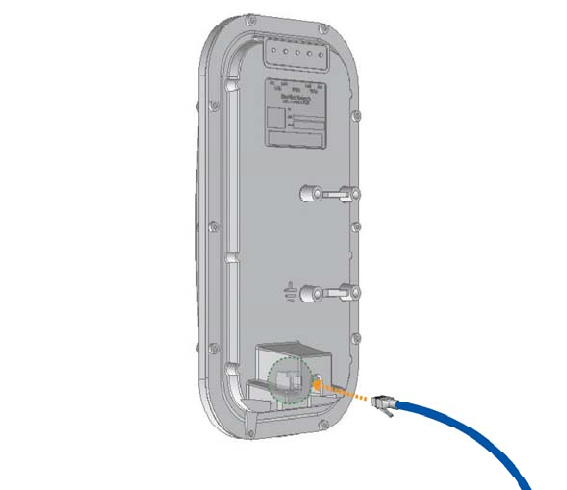
SkyPilot SkyAccess DualBand Installation 21
easier if the device is more accessible. For information about
configuration, see “Configuring the SkyConnector” on page 20.
Cabling the SkyConnector
Ethernet cabling provides power and data connectivity for the
SkyConnector. This section provides instructions for attaching CAT5
cable to the device.
To install CAT-5 cabling:
1 Terminate the appropriate grade and length of CAT-5 cable with an
RJ-45 connector, and plug it into the RJ-45 port on the back of the
SkyConnector.
Make sure the fit is snug so that the cable doesn’t interfere with the
weather gasket.
Figure 3-1. Connecting CAT5 cable to the SkyConnector
2 Insert the weather gasket and secure the metal cover.
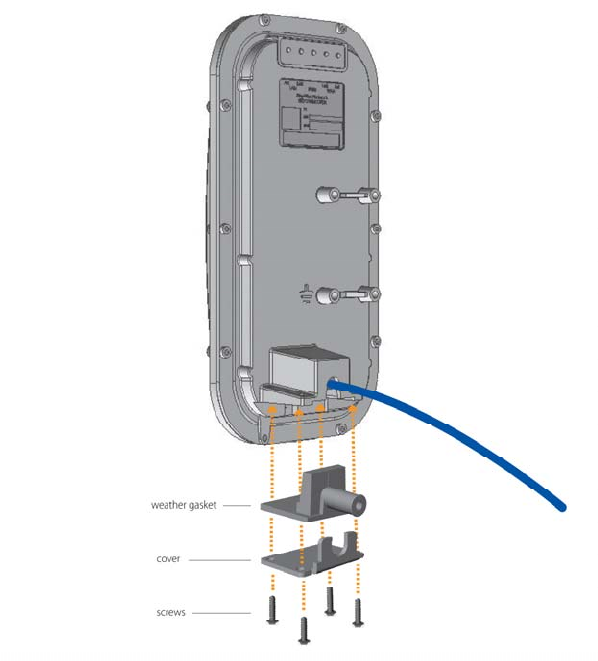
SkyPilot SkyAccess DualBand Installation 22
a. Press the CAT5 cable into the gasket and insert the gasket
into the housing, taking care not to twist or place
unnecessary force on the RJ-45 connector.
b. Fit the metal cover over the weather gasket and secure it
with the four machine screws supplied in the accessory kit
(Figure 3-2).
Figure 3-2. Attaching weather gasket and metal cover
3. Attach the tie wraps to the neck of the weather gasket and tighten
them so that they slightly depress the neck (Figure 3-3).
The tie wraps provide relief from cable strain and ensure a fully
weatherproof seal.
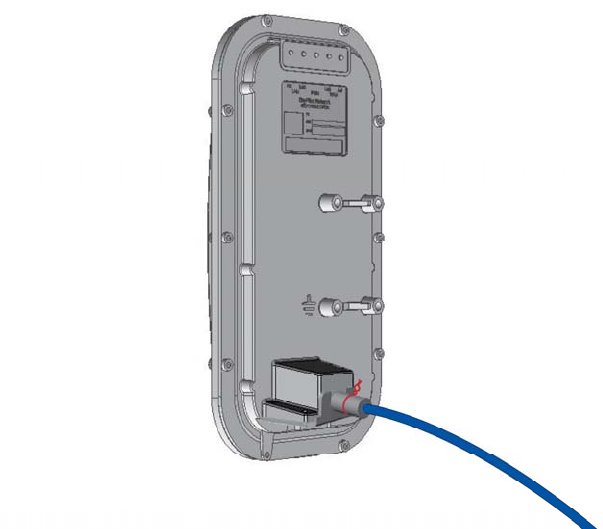
SkyPilot SkyAccess DualBand Installation 23
Figure 3-3. Attaching tie wraps to the gasket neck
Powering on the SkyConnector
Before mounting the SkyConnector, first power on the unit so that you
can use the onboard LEDs to determine optimal placement.
To power on the SkyConnector:
1 Attach the power supply
a. Connect the AC power cord to the AC adapter, and plug it
into an AC outlet.
b. Connect the Ethernet cable to the port labeled “CPE” on the
power injector.
NOTE Be careful not to plug the Ethernet cable connected to the
SkyConnector into the port labeled “Computer.”
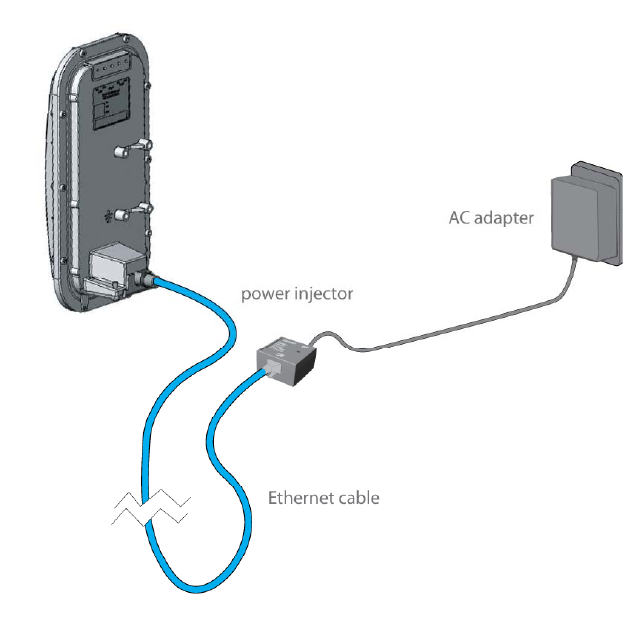
SkyPilot SkyAccess DualBand Installation 24
c. Plug the AC adapter into the power injector.
Figure 3-4. Providing power to the SkyConnector
2 Check the LEDs on the SkyConnector.
If the connections are correct, the SkyConnector’s power LED
(labeled “PWR”) should illuminate and the WAN activity LED (labeled
“WAN Act”) should blink on and off. (For details about the LED status
lights, see Table 3-1 on page 18.)
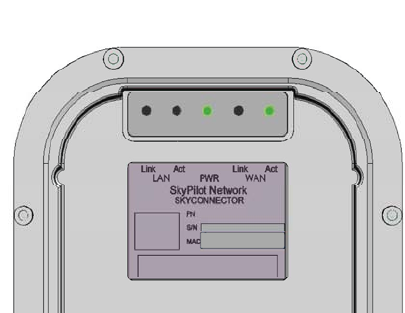
SkyPilot SkyAccess DualBand Installation 25
Figure 3-5. Checking the SkyConnector LEDs
SkyPilot SkyAccess DualBand Installation 26
Optimizing Location
After powering up the SkyConnector, use the device’s LEDs to identify
the optimal location for mounting. (For details about the LED status lights,
see Table 3-1 on page 18.)
To power on the SkyConnector:
1 Confirm signal acquisition.
a. Position the SkyConnector near the intended mounting location
and watch the “WAN Act” LED for activity. The LED starts
blinking when it acquires a signal from the network and is
attempting to make a connection.
If the LED doesn’t start blinking within 30 seconds, try changing
the orientation of the SkyConnector or walk to a new location.
Repeat the process until the LED starts blinking.
b. When the LED starts blinking, make minor adjustments to find
the location where the signal is strongest. (The faster the LED
blinks, the stronger the signal.)
When the LED blinks steadily at a high rate, you have an optimal
signal.
2 Verify network connection.
a. Watch the “WLAN Link” LED for activity. Within 90 seconds of
locating a signal, the LED should start to blink—first slowly, then
more quickly, and finally it should remain steadily lit.
When the “WAN Link” LED is steadily lit and the “WAN Act” LED
is blinking, SkyConnector has established an authorized
connection to the network, indicating that the current location
is suitable for mounting.
If both the “WAN Link” LED and the “WAN Act” LED continue
blinking, a signal is available but isn’t strong enough for reliable
service. Keep trying different locations until you can confirm a
network connection.
SkyPilot SkyAccess DualBand Installation 27
NOTE To optimize your SkyConnector installation, ask your network
administrator (at the Network Operations Center) to measure
signal strength on the node to which SkyConnector has
established a link.
SkyPilot SkyAccess DualBand Installation 28
Monitoring SkyConnector Status
Table 3-1 provides detailed descriptions of SkyConnector states
indicated by the LED lights. When both LED lights are lit and steady, the
SkyConnector is successfully connected to the wireless network.

SkyPilot SkyAccess DualBand Installation 29
Table 1. SkyAccess LED states
LED LED state Device state
LAN Link Steady illumination SkyConnector is connected to
another device via its Ethernet port.
LAN Act Blinking Device is transmitting or receiving
data via its Ethernet port.
PWR Steady illumination Device is powered on.
WAN Link Blinking (fast blink
when device is in
standby mode)
Device is attempting to establish an
authorized connection on the wireless
network.
If both WAN Link and WAN Act
continue to blink, the signal is not
strong enough to support reliable
service or there is a provisioning
problem that’s preventing the device
from coming online. Contact your
network administrator.
Steady illumination Device is connected to the wireless
network.
WAN Act None Device cannot detect a wireless
network.
Blinking Device is within the coverage area of
a wireless network. Blink rate
communicates signal strength:
• Fast (8x per second) = excellent
• Medium (4x per second) = good
• Slow (<1x per second) = poor
• None = no reception
Mounting the SkyConnector
After determining an optimal location for your SkyConnector, you can
mount the device and run the appropriate cables.
SkyPilot SkyAccess DualBand Installation 30
To mount the SkyConnector:
1 Disconnect the CAT-5 cable from the power injector.
2 Power down the SkyConnector.
3 Attach a magnetic level to the 1 1/8" (2.87 cm) and 1 3/8" (3.48 cm)
diameter steel mounting pole to verify that the pole is plumb
(straight).
IMPORTANT It is the installer’s responsibility to verify that the support
pole and its installation method are of sufficient strength to
withstand onsite weather conditions. (The supplied
mounting bracket and screws are certified to withstand a
125 mph wind force.)
4 Use the provided clamps and screws (provided in the accessory kit)
to attach the SkyConnector to the mounting pole (see Figure 3-6).
Before clamping down the bracket, check that the mounting pole is
still plumb and that the SkyConnector is level.
NOTE If the device is not level, performance may be degraded.
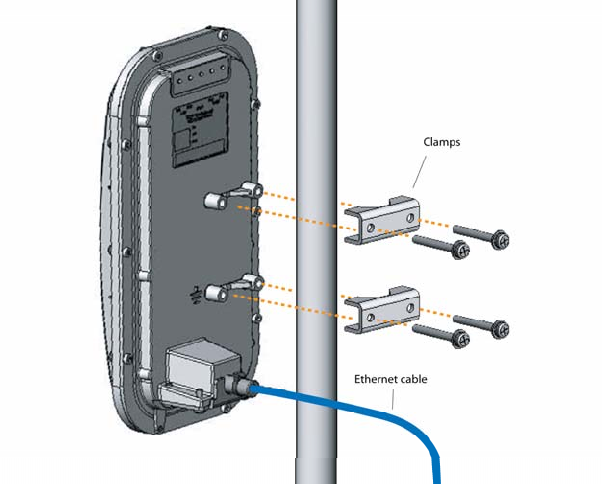
SkyPilot SkyAccess DualBand Installation 31
Figure 3-6. Attaching the SkyConnector
5 Reconnect the CAT-5 cable to the port labeled “CPE” on the
SkyConnector power injector.
Configuring the SkyConnector
To operate on the wireless mesh network, the SkyGateway requires a
network configuration.
A SkyConnector will not transmit a wireless signal until it’s configured,
and it will not be able to connect to other network devices without a
configuration.
SkyPilot offers two modes for provisioning devices with a configuration:
4

SkyPilot SkyAccess DualBand Installation 32
• Automatic - Requires the use of SkyPilot EMS software to create
configurations that an unattended central server can distribute to
devices on the wireless mesh network. Although automatic
provisioning requires more setup time than manual provisioning, it
greatly simplifies the administration of a growing network.
• Manual - Usually performed in the field, manual provisioning permits
the configuration of a single device at a time, creating the minimum
settings required for a wireless link and storing them in the device’s
flash (nonvolatile) memory. Manual provisioning is a logical choice if
you’re installing a test network or rolling out a small-scale installation
that isn’t expected to expand.
For more information about provisioning modes and procedures, refer to
Getting Started with the SkyPilot Network and SkyPilot Network
Administration, available from the SkyPilot website at
www.skypilot.com/support/.
Accessing the Command-Line Interface
SkyPilot devices include a command-line interface which you can use for
manual provisioning and troubleshooting.
You can connect to a device and access its command-line interface
through Telnet over an Ethernet connection or via a terminal session
from a console connected to the device’s RJ-45 serial port. After logging
in (by supplying a password), you can enter commands at the command
prompt.
For detailed cabling and access instructions for the command-line
interface, refer to the SkyPilot Command-Line Interface Reference.
SkyPilot SkyAccess DualBand Installation 33
Troubleshooting
After making an Ethernet or serial connection to the SkyConnector, you
can manage and troubleshoot the device using a wide range of
commands available through the command-line interface.
For detailed troubleshooting procedures, refer to the “Troubleshooting”
section in SkyPilot Network Administration. There you’ll find
troubleshooting procedures for:
• Power-on problems
• Ethernet connectivity problems
• IP connectivity problems
• SkyGateway transmission problems
• Link failure problems

SkyPilot SkyAccess DualBand Installation 35
Grounding Guidelines
This appendix provides some guidelines for properly grounding the
SkyPilot Connector.
Proper grounding protects both your SkyPilot device and equipment
connected to it. For the surge protection circuitry built into the SkyPilot
equipment to be effective, proper grounding of the unit is necessary. This
is especially true if you’re installing devices on tall structures, or in areas
subject to lightning.
NOTE The techniques described in this appendix are intended as
general guidelines only and do not constitute a comprehensive
guide covering all installation scenarios. For maximum protection,
contact a qualified installation specialist who is familiar with your
operating environments. If lightning is a threat in your area,
consider a consultation with a lightning and transient protection
specialist.
General Grounding Strategy
To ensure optimal reliability, properly ground the metal base of the
SkyPilot device. The most efficient way to ground the device is to use an
8 GA or larger wire to connect it to a ground point on the structure or
tower.
The three most common ground points are:
• A cold-water pipe. Make sure it is well connected to earth.
A
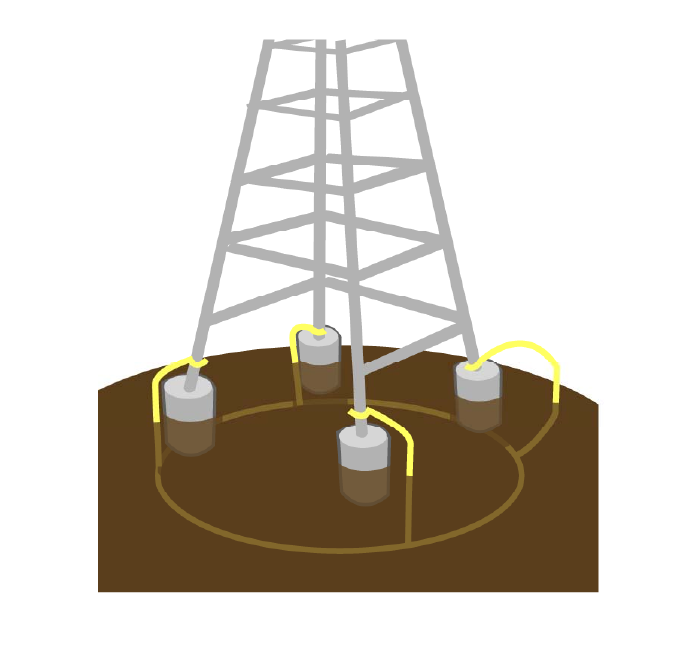
SkyPilot SkyAccess DualBand Installation 36
• The primary grounding point of the AC electrical system of the
building.
• A 10-foot or longer copper-clad ground rod driven into the earth. For
a tower with multiple legs, you need one ground rod per leg and a
ground wire loop connecting each of the rods; see Figure 12.
Figure A1-1. Attaching the SkyConnector
Making Connections “Gas-Tight”
Regardless of the grounding point you use, make sure the connections
are “gas-tight” - capable of retaining low resistance and integrity over
time and with exposure to the elements.

SkyPilot SkyAccess DualBand Installation 37
Use of an antioxide compound and proper sealing is essential. For
protection against corrosion, wrap all connections with Scotch® 130C
tape.
Checking Cold-Water Pipe Integrity
If you’re using a cold-water pipe for grounding, verify the integrity of the
ground. In some cases, sections of metal cold-water pipes may have
been repaired or extended with PVC material. PVC material or a
dielectric union will render a cold-water pipe ground unacceptable for
grounding.
Measuring Resistance
Verify that there is no more than 5 ohms of resistance between any two
ground points in the entire system. Also make sure that all ground points
on a structure are tied together. For example, if you use a ground rod and
a cold-water pipe as grounding points at different locations on the same
structure, you must tie them together.
Adding Surge Protection
If you’re installing a SkyPilot device in an area that’s subject to lightning
storms, SkyPilot recommends installing a surge protection device (SPD)
at both ends of the Ethernet cable - one at the SkyPilot device and one at
the point of entry to a building or enclosure.
SkyPilot offers SPDs with bracket and cabling designed for use with
SkyPilot equipment. For more information, visit SkyPilot customer
support at www.skypilot.com/support/ to view accessory guides for
SkyPilot-branded surge protection solution. (You may also purchase
SPDs from third-party vendors.)
SkyPilot SkyAccess DualBand Installation 38
Grounding Checklist
When grounding a SkyPilot device, use the following checklist to confirm
that your installation is adequately protected from power surges and
lightning.
• Connect a ground wire from the SkyPilot device to a ground system
on the building or tower.
• Use shielded CAT5 cabling and connect the drain wire of the shield to
ground at the SkyPilot device. (Leave the other end of the drain wire
unconnected.)
• Use the proper size down lead to connect a SkyPilot device on a roof
or tower to the ground system of indoor equipment.
• Verify that all points of the ground system are tied together with less
than 5 ohms resistance between any two points.
• Run the CAT5 cable inside the tower structure, tying the cable to the
tower leg at every 4 feet of length. For increased protection, run the
CAT5 cable through metallic conduit installed on the tower.
• Bleed off any static charge by installing a streamer-delaying, static-
dissipation array above the SkyPilot device.
• Install all lightning and surge protection devices in accordance with
UL 96A installation requirements for lightning protection systems and
the NFPA 780 standard for lightning protection.

SkyPilot SkyAccess DualBand Installation 39
FCC Statements
FCC Radio Frequency Interference Statement
This equipment has been tested and found to comply with the limits for a
Class B digital device, pursuant to Part 15 of the FCC Rules. These limits
are designed to provide reasonable protection against harmful
interference in a residential installation. This equipment generates, uses
and can radiate radio frequency energy and, if not installed and used in
accordance with the instructions, may cause harmful interference to radio
communications. However, there is no guarantee that interference will
not occur in a particular installation. If this equipment does cause harmful
interference to radio or television reception, which can be determined by
turning the equipment off and on, the user is encouraged to try to correct
the interference by one or more of the following measures:
• Reorient or relocate the receiving antenna.
• Increase the distance between the equipment and the receiver.
• Connect the equipment to an outlet on a circuit different from that to
which the receiver is connected.
• Consult the dealer or an experienced radio/TV technician for help.
FCC Radiation Exposure Limits
To comply with FCC RF exposure requirements in section 1.1307, a
minimum separation distance of 40 cm (16 inches) is required between
the antenna and all persons.
B

SkyPilot SkyAccess DualBand Installation 40
Specifications
This appendix provides technical specifications for the SkyPilot
SkyConnector.
Wireless Specifications
Frequency bands capable
US & Canada
SP 4100
SP 4304
For other countries check with
sales representative
5.5GHz to 5.725GHz
5.26 GHz to 5.32 GHz
EIRP 29 dBm/0.9 W peak,
Media access Time Division Duplex (TDD)
Modulation technique OFDM with adaptive modulation
Modulation rates 6–54 Mbps
Throughput Up to 20 Mbps UDP, up to 10 Mbps TCP
Latency 8–10 ms roundtrip per hop
Antennas 28° horizontal x 9° vertical panel, 16.5 dBi
Channel width 20 MHz
C

SkyPilot SkyAccess DualBand Installation 41
Channel resolution 5 MHz frequency control
Receive sensitivity -90 dBm at 6 Mbps modulation
Connectivity SkyConnector connects with SkyGateways,
SkyExtenders, and SkyExtender DualBands
Authentication MD5-based certificates
Encryption 128-bit AES on all wireless links
Product Specifications
Connectors RJ-45: Ethernet connection (10/100bT) and
power (Power-over-Ethernet)
Mounting Eave, roof, or chimney; outside pole diameter
up to 2.0"
Range 7.5 miles (12 km)
LEDs Wireless activity, wireless link, LAN activity,
LAN link, and power
Dimensions 12.6" (32 cm) H x 6.6" (16.8 cm) W x 4.2" (10.7
cm) D
Weight 3.8 pounds (1.7 kg)
Operating temperature -40° to 131° F (-40° to 55° C)
Wind loading Up to 150 mph (240 km/h)
Enclosure/humidity NEMA-4X
Power 110–230 VAC, 50–60 Hz input; 8 W
Certifications FCC Part 9, FCC 47 CFR Part 15, Class B
USA; compliance with UL safety standards,
EMI and susceptibility FCC Part 15.107 and 15.109

SkyPilot SkyAccess DualBand Installation 42
Warranty One-year limited warranty on hardware and
software
Security
Authentication MD5-based certificates
Encryption AES
Filtering Based on protocol type, IP port ID, and
configurable IP address list
Network Management
Command-line interface Console via Telnet
NMS integration SNMP v2c
GUI configuration SkyProvision™ software and Web interface
GUI EMS SkyControl™ software
IP address DHCP or static
Firmware Multiple versions of firmware stored in
nonvolatile memory; updated via FTP
Configuration file XML over HTTP

SkyPilot SkyAccess DualBand Installation 43
Quality of Service
Prioritization 802.1p-based; based on protocol type, IP
address, port ID, and configurable IP address
list
Traffic shaping Per-device rate limits upstream and
downstream
Monitoring and MIB Support
Supported MIBs MIB-II (RFC 1213); EtherLike (RFC 2665);
Bridge (RFC 1493); SkyPilot private MIB
Local management RS-232 Serial Console Port
Remote management Command-line interface via Telnet, SNMP v2c,
Web interface
Topology
Configurations Mesh, point-to-point